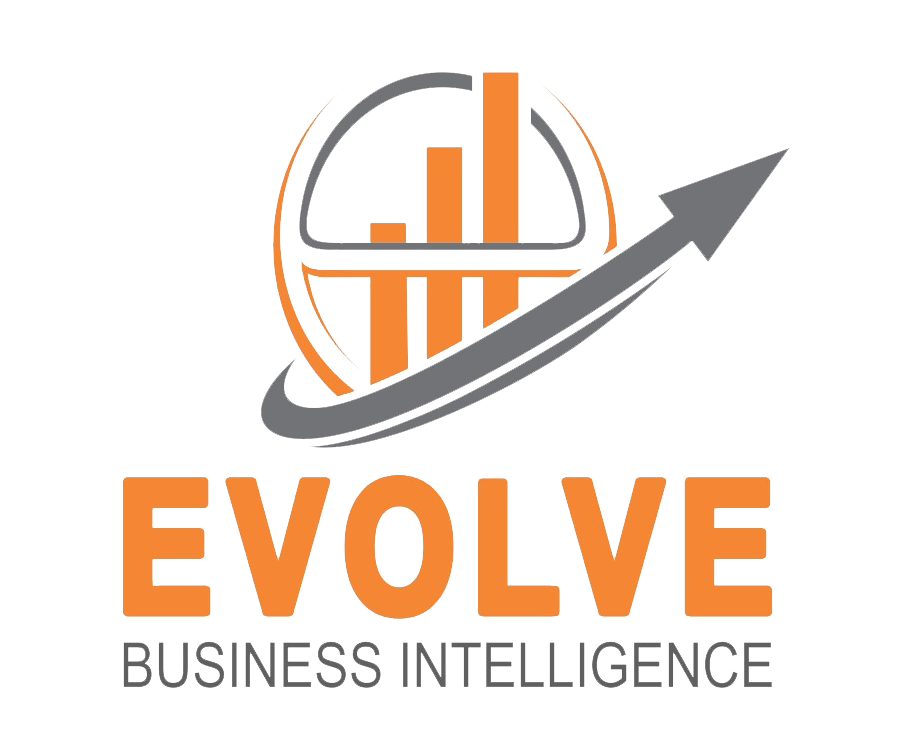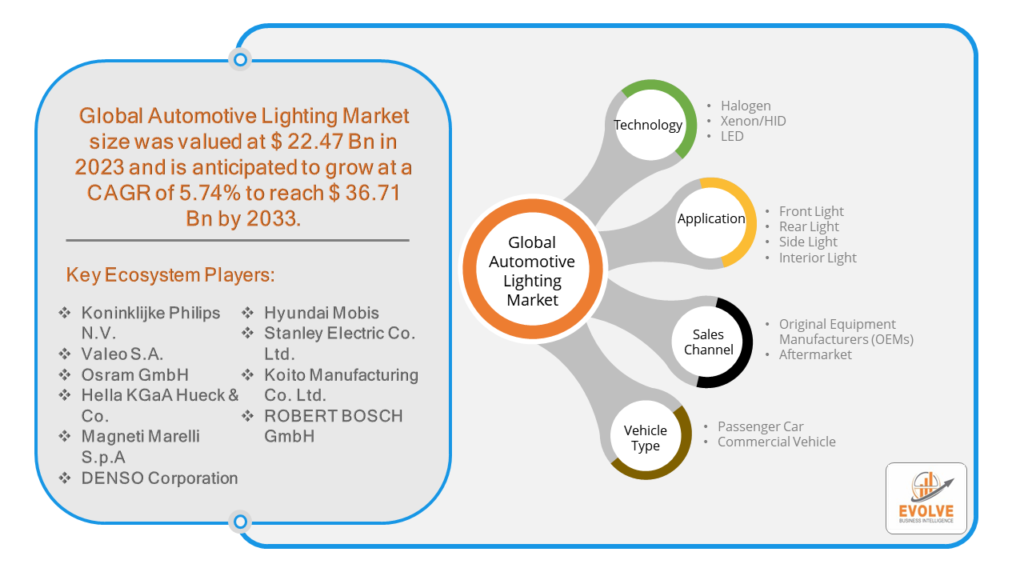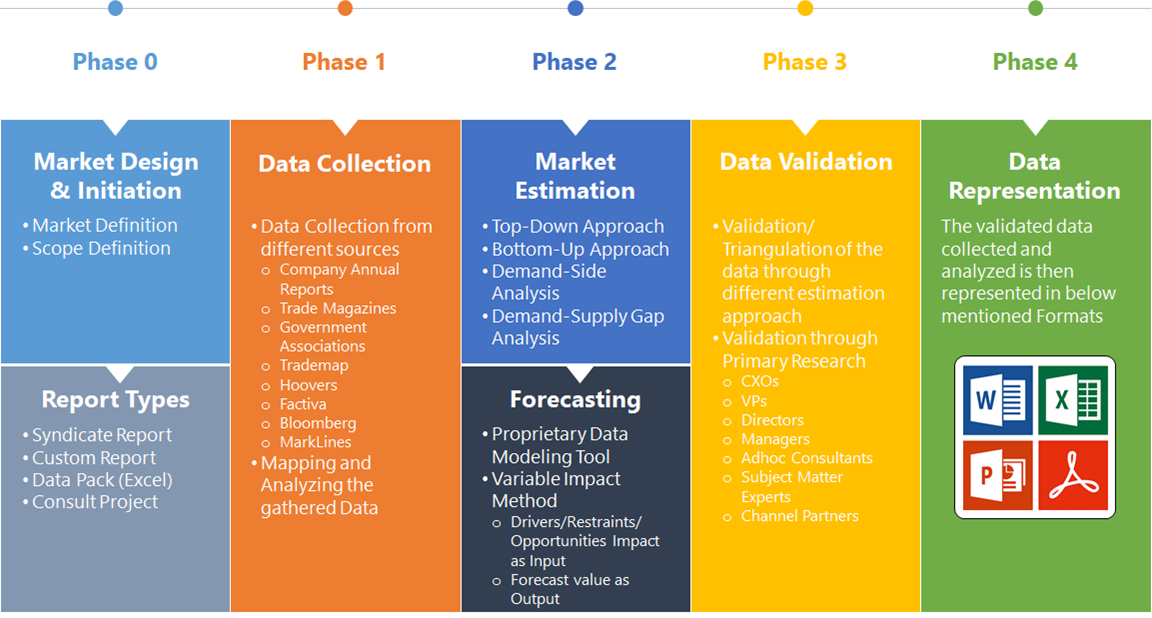Automotive Lighting Market Overview
Automotive Lighting Market Size is expected to reach USD 36.71 Billion by 2033. The Automotive Lighting industry size accounted for USD 22.47 Billion in 2023 and is expected to expand at a compound annual growth rate (CAGR) of 5.74% from 2023 to 2033. The automotive lighting market is a rapidly growing industry, with a total revenue of US$ 27.7 billion in 2017. This market is driven by exterior lighting, particularly headlamps, which generate more than two-thirds of the total market revenue.The increasing adoption of LED technology in automotive lighting is a significant trend, with the number of LEDs in modern cars expected to increase from €25/vehicle to €35/vehicle by 2023.The new generation of LEDs, the µ-LED, is expected to play a major role in this market segment.The automotive lighting market is dominated by five major players, including Japan’s Koito and Stanley, Italy’s Magneti Marelli, France’s Valeo, and Germany’s Hella.The market is expected to grow at a CAGR of 57% between 2016 and 2022, reaching US$ 35.9 billion by 2022.The largest markets for automotive lighting are North America, Europe, and South Asia, with adoption being driven by cities looking to reduce high energy and labor costs
Global Automotive Lighting Market Synopsis
The COVID-19 pandemic has had a significant impact on the automotive lighting market, with the crisis slowing down supply chains, hampering business growth, and increasing panic among customer segments.Governments across different regions announced total lockdown and temporarily shutdown of industries, which adversely affected the overall production and sales.The global business outlook has changed dramatically post COVID-19 health crisis, with the overall production activities of market players declining due to operations with limited workforce capacity and inadequate health safety measures along with current demand dynamics.The automobile & transportation sector came to a halt due to the imposed lockdown across the globe, which has also created an adverse effect on the automotive industry across the globe.
Global Automotive Lighting Market Dynamics
The major factors that have impacted the growth of Automotive Lighting are as follows:
Drivers:
⮚ Technological Advancements
Continuous advancements in lighting technology, such as LED and OLED lighting, enable automotive manufacturers to offer energy-efficient, durable, and aesthetically appealing lighting solutions. These advancements attract consumers and drive market growth.
Restraint:
- Limited Consumer Awareness
Despite the technological advancements in automotive lighting, some consumers may have limited awareness of the benefits of advanced lighting systems or may not prioritize them when making purchasing decisions. Educating consumers about the safety and aesthetic advantages of advanced lighting technologies may be necessary to drive adoption.
Opportunity:
⮚ Smart Lighting Systems
The integration of smart lighting systems in vehicles presents opportunities for enhanced functionality and user experience. Features such as adaptive headlights, dynamic turn signals, and ambient lighting controlled via smartphone apps or voice commands can differentiate vehicles in the market and drive consumer demand.
Automotive Lighting Market Segment Overview
By Technology
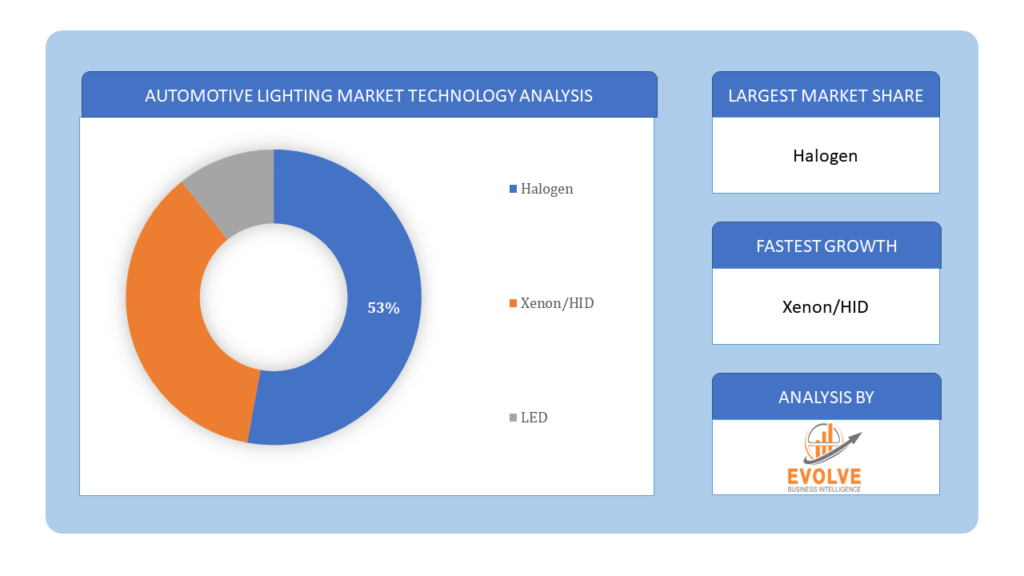 Based on the Technology, the market is segmented based on Halogen, Xenon/HID, and LED. The LED segment’s adaptive lighting technology allows for automatic adjustments to the illumination of the road ahead, it is projected to hold the biggest market share over the forecast period. When compared to traditional lighting, LED headlights are the most efficient, producing more light with less heat.
Based on the Technology, the market is segmented based on Halogen, Xenon/HID, and LED. The LED segment’s adaptive lighting technology allows for automatic adjustments to the illumination of the road ahead, it is projected to hold the biggest market share over the forecast period. When compared to traditional lighting, LED headlights are the most efficient, producing more light with less heat.
By Sales Channel
Based on Sales Channel, the market has been divided into Original Equipment Manufacturers (OEMs) and Aftermarket. OEMs cater to lighting requirements during vehicle production, while the Aftermarket sector addresses replacement and customization needs post-purchase.
By Vehicle Type
Based on the Vehicle Type, the market has been divided into Passenger Car and Commercial Vehicle. The increase in demand for advance technology-based automotive lighting has resulted in the growth of the passenger car segment. The rising production of passenger automobiles is a result of the growing demand for these vehicles among consumers. The increasing use of lighting systems both inside and outside of cars is a result of the rising manufacturing of passenger cars.
By Application
Based on Application, the market has been divided into Front Light, Rear Light, Side Light, and Interior Light. Front lights segment dominated the global market in 2022. The market for front light applications has been primarily driven by rising passenger car demand and technical developments in the automotive sector.
Global Automotive Lighting Market Regional Analysis
Based on region, the market has been divided into North America, Europe, Asia-Pacific, the Middle East & Africa, and Latin America. The area of Asia Pacific is anticipated to dominate the market for the usage of Automotive Lighting, followed by those in North America and Europe.
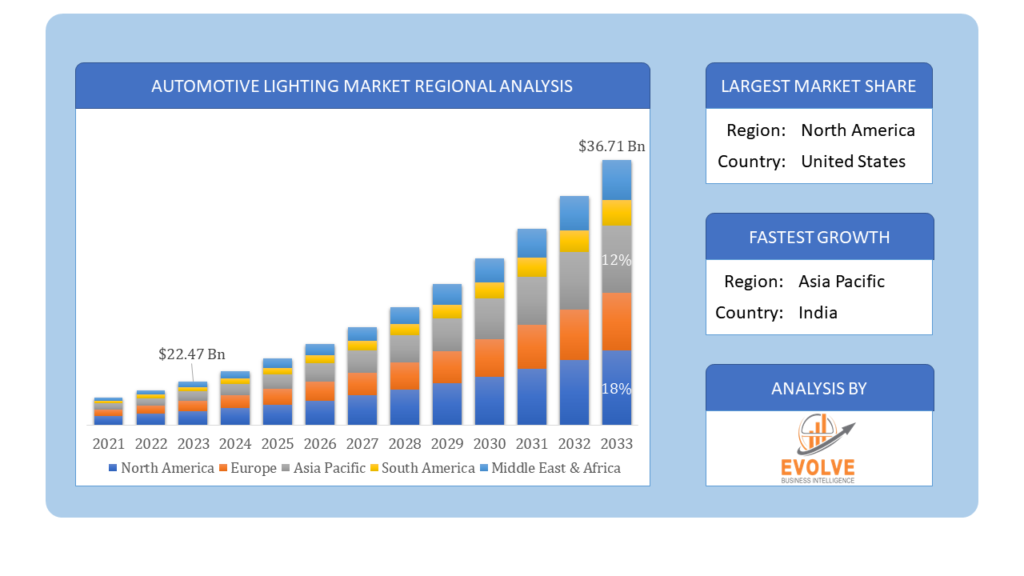 Automotive Lighting Asia Pacific Market
Automotive Lighting Asia Pacific Market
The Asia Pacific region holds a dominant position in the Automotive Lighting market. In 2022, the Asia Pacific Automotive Lighting market held a 45.80% market share. This is due to the ease of obtaining raw materials and the significant demand for reasonably priced electrical and mechanical components from nations like China, India, and Japan. Furthermore, in the Asia-Pacific area, the Indian market was expanding at the fastest rate, while China’s automotive lighting market retained the most market share.
Automotive Lighting North America Market
The North America region is witnessing rapid growth and emerging as a significant market for the Automotive Lighting industry. From 2023 to 2032, the North American automotive lighting market is anticipated to develop significantly. The early acceptance of Advanced Driver Assistance System (ADAS) features and the rise in sales of electric vehicles in North America can be attributed to the swift adoption of the automotive lighting system.
Competitive Landscape
The competitive landscape includes key players (tier 1, tier 2, and local) having a presence across the globe. Companies such as Koninklijke Philips N.V., Valeo S.A., Osram GmbH, Hella KGaA Hueck & Co., and Magneti Marelli S.p.A are some of the leading players in the global Automotive Lighting Industry. These players have adopted partnership, acquisition, expansion, and new product development, among others as their key strategies.
Key Market Players:
- Koninklijke Philips N.V.
- Valeo S.A.
- Osram GmbH
- Hella KGaA Hueck & Co.
- Magneti Marelli S.p.A
- DENSO Corporation
- Hyundai Mobis
- Stanley Electric Co. Ltd.
- Koito Manufacturing Co. Ltd.
- ROBERT BOSCH GmbH
Key Development:
In September 2023, DENSO Corporation announced a breakthrough in automotive lighting technology with the unveiling of their advanced adaptive LED headlight system. Incorporating cutting-edge sensors and AI algorithms, the system dynamically adjusts light distribution to enhance visibility while minimizing glare for oncoming traffic, setting a new standard for safety and innovation in automotive lighting.
Scope of the Report
Global Automotive Lighting Market, by Technology
- Halogen
- Xenon/HID
- LED
Global Automotive Lighting Market, by Sales Channel
- Original Equipment Manufacturers (OEMs)
- Aftermarket
Global Automotive Lighting Market, by Vehicle Type
- Passenger Car
- Commercial Vehicle
Global Automotive Lighting Market, by Application
- Front Light
- Rear Light
- Side Light
- Interior Light
Global Automotive Lighting Market, by Region
- North America
- US
- Canada
- Mexico
- Europe
- UK
- Germany
- France
- Italy
- Spain
- Benelux
- Nordic
- Rest of Europe
- Asia Pacific
- China
- Japan
- South Korea
- Indonesia
- Austalia
- Malaysia
- India
- Rest of Asia Pacific
- South America
- Brazil
- Argentina
- Rest of South America
- Middle East & Africa
- Saudi Arabia
- UAE
- Egypt
- South Africa
- Rest of Middle East & Africa
| Parameters | Indicators |
|---|---|
| Market Size | 2033: $36.71 Billion |
| CAGR | 5.74% CAGR (2023-2033) |
| Base year | 2022 |
| Forecast Period | 2023-2033 |
| Historical Data | 2021 |
| Report Coverage | Revenue Forecast, Competitive Landscape, Growth Factors, and Trends |
| Key Segmentations | Technology, Sales Channel , Vehicle Type, Application |
| Geographies Covered | North America, Europe, Asia-Pacific, Latin America, Middle East, Africa |
| Key Vendors | Koninklijke Philips N.V., Valeo S.A., Osram GmbH, Hella KGaA Hueck & Co., Magneti Marelli S.p.A, DENSO Corporation, Hyundai Mobis, Stanley Electric Co. Ltd., Koito Manufacturing Co. Ltd., ROBERT BOSCH GmbH |
| Key Market Opportunities | Evolution of new technologies |
| Key Market Drivers | Strict government regulations on lighting for better visibility and safety and increasing adoption of advanced lighting in vehicles |
REPORT CONTENT BRIEF:
- High-level analysis of the current and future Automotive Lighting Industry trends and opportunities
- Detailed analysis of current market drivers, restraining factors, and opportunities analysis in the future
- Historical market size for the year 2021, and forecast from 2023 to 2033
- Automotive Lighting market share analysis for each segment
- Competitor analysis with a comprehensive insight into its product segment, financial strength, and strategies adopted.
- Identifies key strategies adopted by the key players including new product development, mergers and acquisitions, joint ventures, collaborations, and partnerships.
- To identify and understand the various factors involved in the global Automotive Lighting market affected by the pandemic
- To provide year-on-year growth from 2022 to 2033
- To provide short-term, long-term, and overall CAGR comparison from 2022 to 2033.
- Provide Total Addressable Market (TAM) for the Global Automotive Lighting Market.
